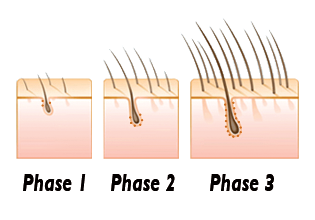How Much Hair Growth Is Expected 4 Months after Hair Transplant Surgery?
The following thorough response to a question from the Hair Restoration Social Community and Discussion Forums, was written by forum member “Gillenator”.
What is the reasonable expectation of hair sprouting from the skin at 4 months post hair transplant? I know for a fact that not all grafts will pierce the skin and grow by 4 months but if we were to put a % estimate of the grafts that might have already pierced the skin by month 4, how much would you think grows by that time?
Some guys here suggested that by 3-4 months max, almost all viable hair has sprouted and after that, it’s only maturing and thickening. Is that even true ?
 Good question. Let me first state that there are variables and other factors that can affect the hair growth timetable so possibly I can just express what is the normality when the hair restoration surgeon is skilled and competent.
Good question. Let me first state that there are variables and other factors that can affect the hair growth timetable so possibly I can just express what is the normality when the hair restoration surgeon is skilled and competent.
At 3-4 months post-op, the regrowth is just starting to break above the scalp line and very little new growth is visible for a large percent of patients. In my opinion, that is attributable to the fact that a much larger amount of the transplanted hair follicles go into the telogen phase 2-3 weeks post-op and rest for another 3 months in that dormant phase.
The nice thing about using high powered magnification is that it is possible to see the new hair bristles just starting to break surface and some that are directly below the surface, especially those individuals with dark hair color.
No, it’s just not true that almost all of the regrowth has sprouted about the scalp line and visible at 3-4 months post-op. It’s just starting to sprout and that is for a much higher percent of patients across the board. It’s really at the 5-7 month period that the regrowth is coming through on average 75% of the grafts and very visible.
Exceptions? Sure. Let me explain. Follicular unit extraction (FUE) surgeons who are very skilled with their manual extraction techniques can see two things improve. More of the grafts remain in the growth phase and yes the regrowth can occur faster because there is less overall trauma to the grafts. If the trauma can be reduced, then a higher percent of the follicles can potentially remain in the growth phase. And we hear this more often when guys say that some of their grafts do not shed as quickly and continue to grow immediately post-op.
Some of the top docs are also coating or placing the grafts in cool solutions like ACell that can reduce the volume of free radicals that can begin to fester and attach to the grafts once they are taken out of the scalp. This is true for both follicular unit strip surgery (FUSS) and FUE. The quicker that the graft tissue is placed back into the scalp, the better. Yield improves and so can the regrowth period.
But it’s hard to say what percentage because first of all, there are very few clinical studies or documentation being done to show/prove the variations. I consider Dr. Cooley to be one of the top and very few docs who are devoted to clinical improvements in this area, including the documentation to support it. It’s also hard for me to say which docs go the extra mile in graft preservation because I don’t work for them.
It’s in the result that counts…and after all, that’s what we all want.
Gillenator
Supporting Hair Restoration Physicians: Dr. Glenn Charles, Boca Raton, FL – Dr. Jerry Cooley, Charlotte, NC – Dr. Jim Harris, Denver, CO – Dr. Robert True & Dr. Robert Dorin, New York, NY
—-
David (TakingThePlunge)
Editorial Assistant and Forum Co-Moderator for the Hair Transplant Network, the Coalition Hair Loss Learning Center, and the Hair Loss Q & A Blog.
To share ideas with other hair loss sufferers visit the hair loss forum and social community.
Technorati Tags: hair transplant, hair growth, hair restoration, Follicular unit extraction, FUE, ACell, follicular unit strip surgery, FUSS
